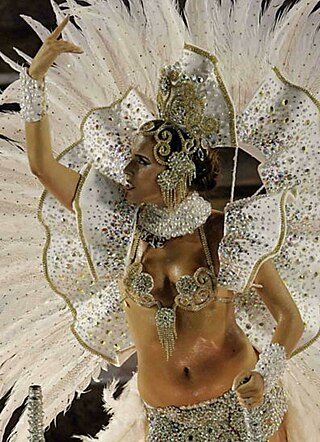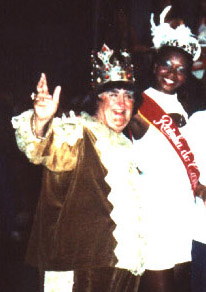
Carnival or Shrovetide is a Christian festive season that occurs before Lent. Shrovetide begins with Quinquagesima Sunday and ends with Shrove Tuesday or Mardi Gras.

The Carnival of Brazil is an annual festival held the Friday afternoon before Ash Wednesday at noon, which marks the beginning of Lent, the forty-day period before Easter. During Lent, Roman Catholics and some other Christians traditionally abstained from the consumption of meat and poultry, hence the term "carnival", from carnelevare, "to remove meat."

A samba school is a dancing, marching, and drumming club. They practice and often perform in a huge square-compounds and are devoted to practicing and exhibiting samba, an Afro-Brazilian dance and drumming style. Although the word "school" is in the name, samba schools do not offer instruction in a formal setting. Samba schools have a strong community basis and are traditionally associated with a particular neighborhood. They are often seen to affirm the cultural validity of the Afro-Brazilian heritage in contrast to the mainstream education system, and have evolved often in contrast to authoritarian development. The phrase "escola de samba" is popularly held to derive from the schoolyard location of the first group's early rehearsals. In Rio de Janeiro especially, they are mostly associated with poor neighborhoods ("favelas"). Samba and the samba school can be deeply interwoven with the daily lives of the shanty-town dwellers. Throughout the year the samba schools have various happenings and events, most important of which are rehearsals for the main event which is the yearly carnival parade. Each of the main schools spend many months each year designing the theme, holding a competition for their song, building the floats and rehearsing. It is overseen by a carnavalesco or carnival director. From 2005, some fourteen of the top samba schools in Rio have used a specially designed warehouse complex, the size of ten football pitches, called Samba City to build and house the elaborate floats. Each school's parade may consist of about 3,000 performers or more, and the preparations, especially producing the many different costumes, provide work for thousands of the poorest in Brazilian society. The resulting competition is a major economic and media event, with tens of thousands in the live audience and screened live to millions across South America.

Conspiracy of the Pintos, also known as the Pinto Revolt or the Pinto Conspiracy, and in Portuguese as A Conjuração dos Pintos, was a rebellion against Portuguese rule in Goa in 1787. The leaders of the plot were three prominent priests from the village of Candolim in the concelho of Bardez, Goa. They belonged to the Pinto clan, hence the name of the rebellion.

The Barranquilla's Carnival is one of Colombia's most important folkloric celebrations, and one of the biggest carnivals in the world. The carnival has traditions that date back to the 19th century. Four days before Lent, Barranquilla decks itself out to receive national and foreign tourists to join together with the city's inhabitants to enjoy four days of intense festivities. During the carnival, Barranquilla's normal activities are put aside as the city gets busy with street dances, musical and masquerade parades. The Carnival Of Barranquilla includes dances such as the Spanish paleo, African Congo, and indigenous mice y mica's. Many styles of Colombian music are also performed, most prominently cumbia, and instruments include drums and wind ensembles. The Carnival of Barranquilla was proclaimed a Cultural Masterpiece of the Nation by Colombia's National Congress in 2002. Also the UNESCO, in Paris on November 7, 2003, declared it one of the Masterpieces of the Oral and Intangible Heritage of Humanity, and it was during Olga Lucia Rodriquez Carnival Queen year.

The Carnival in Rio de Janeiro is a festival held every year before Lent; it is considered the biggest carnival in the world, with two million people per day on the streets. The first Carnival festival in Rio occurred in 1723.

King Momo or King Momos or King Momus, is considered the king of Carnivals in numerous Latin American festivities, mainly in Brazil and Colombia. His appearance signifies the beginning of the Carnival festivities. Each carnival has its own King Momo, who is often given the key to the city. Traditionally, a tall, fat man is chosen to fulfill the role because the original King Momo was of that physical stature.
The island of Divar lies in the Mandovi river in the Indian state of Goa.
Goan Catholics are an ethno-religious community of Indian Christians adhering to the Latin Rite of the Catholic Church from the Goa state, in the southern part of the Konkan region along the west coast of India. They are Konkani people and speak the Konkani language.
This is a timeline of Goan history. It overlaps with the histories of other regions in South Asia, the Indian subcontinent, and colonial powers that influenced the region, including Portugal.

Bahian Carnival is the annual carnival festival celebrated in the Brazilian state of Bahia, mainly in its capital, Salvador. The event officially lasts for six days, beginning on the Thursday before Ash Wednesday and concluding on Ash Wednesday at noon. The term may also be used to comprise related events that happen immediately before or after, extending the duration for up to twelve days.
The Grêmio Recreativo Escola de Samba Acadêmicos do Grande Rio is a samba school of the Special Group of the carnival of the city of Rio de Janeiro, being headquartered on Almirante Barroso street in Duque de Caxias.
The Culture of Goan Catholics is a blend of Portuguese and Konkani cultures, with the former having a more dominant role because the Portuguese ruled Goa directly from 1510 to 1961.
The Grêmio Recreativo Escola de Samba União da Ilha do Governador was founded on March 7, 1953 by the friends Maurício Gazelle, and Quincas Orphylo, who were in Cacuia, the main site of the carnival parade of the Ilha do Governador, watching the presentation of small schools of samba and blocks of various districts of the island. It was then decided that the neighborhood of Cacuia should be represented by a samba school. Currently, the school is based in Estrada do Galeão in the neighborhood of Cacuia.

Grêmio Recreativo Escola de Samba Unidos de Vila Isabel is a samba school in Rio de Janeiro. It was thrice champion of the Special Group and is currently headquartered in Boulevard 28 de Setembro in Vila Isabel.

São Mathias also known as Malar is a village on Divar Island, Tiswadi or Ilhas, in the Indian state of Goa. The island is located 10 km upriver from Panjim.

The Carnival of Madeira is an annual festival held forty days before Easter, that ends on Shrove Tuesday the day before Ash Wednesday. On certain days of Lent, Roman Catholics traditionally abstained from the consumption of meat and poultry, hence the term "carnival," from carnelevare, "to remove meat."
Carnival in Mexico is celebrated by about 225 communities in various ways, with the largest and best known modern celebrations occurring in Mazatlán and the city of Veracruz.

Waldemar Esteves da Cunha was at the time of his death in 2013, the oldest King Momo in Brazil.

Goa is a state on the southwestern coast of India within the Konkan region, geographically separated from the Deccan highlands by the Western Ghats. It is bound by the Indian states of Maharashtra to the north, and Karnataka to the east and south, with the Arabian Sea in the west. It is India's smallest state by area and fourth-smallest by population. Goa has the highest GDP per capita among all Indian states, two and a half times as high as the GDP per capita of the country as a whole. The Eleventh Finance Commission of India named Goa the best-placed state because of its infrastructure, and India's National Commission on Population rated it as having the best quality of life in India. It is the second-highest ranking among Indian states in the human development index.














